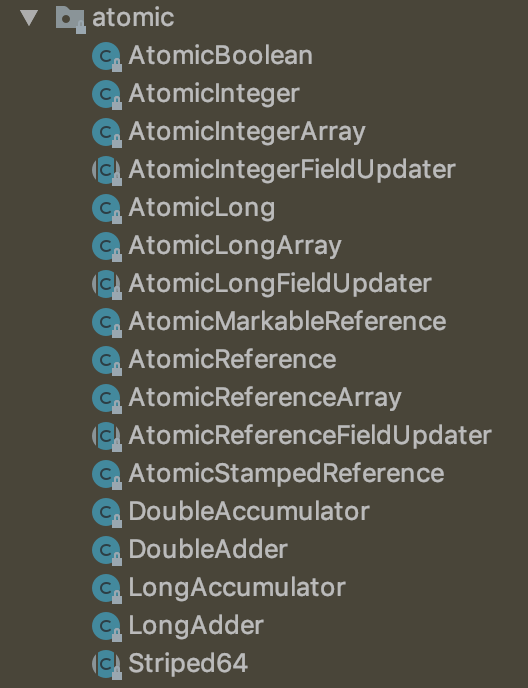Java并发编程之J.U.C中Atomic原子包总结
类型
基本类型
- AtomicInteger:整型原子类
- AtomicLong:长整型原子类
- AtomicBoolean:布尔型原子类
# 示例
import java.util.concurrent.atomic.AtomicInteger;
class AtomicTest {
public static void main(String[] args) {
int temp;
AtomicInteger atomicInteger = new AtomicInteger(0);
temp = atomicInteger.getAndIncrement(); // 相当于i++
System.out.println("Old Value:" + temp + " New Value:" + atomicInteger); // Old Value:0 New Value:1
temp = atomicInteger.incrementAndGet(); // 相当于++i
System.out.println("Old Value:" + temp + " New Value:" + atomicInteger); // Old Value:2 New Value:2
}
}
数组类型
- AtomicIntegerArray:整型数组原子类
- AtomicLongArray:长整型数组原子类
- AtomicBoolean:布尔型原子类
# 示例
import java.util.concurrent.atomic.AtomicIntegerArray;
class AtomicTest {
public static void main(String[] args) {
int[] num = {1, 2, 3, 4, 5};
AtomicIntegerArray array = new AtomicIntegerArray(num);
array.getAndSet(1,5);
System.out.println(array); // [1, 5, 3, 4, 5]
array.compareAndSet(1,5,7);
System.out.println(array); // [1, 7, 3, 4, 5]
}
}
引用类型
- AtomicReference:引用类型原子类
- AtomicStampedRerence:原子更新带有版本号的引用类型(可用于解决CAS中ABA问题)
- AtomicMarkableReference:原子更新带有标记位的引用类型
# 示例
import lombok.AllArgsConstructor;
import lombok.Data;
import java.util.concurrent.atomic.AtomicReference;
class AtomicTest {
public static void main(String[] args) {
AtomicReference<User> atomicReference = new AtomicReference<>();
User user = new User("icharle", 18);
atomicReference.set(user);
System.out.println("name:" + atomicReference.get().getName() + " age:" + atomicReference.get().getAge()); // name:icharle age:18
User newUser = new User("mlui", 19);
atomicReference.compareAndSet(user, newUser);
System.out.println("name:" + atomicReference.get().getName() + " age:" + atomicReference.get().getAge()); // name:mlui age:19
}
}
对象属性修改类型
- AtomicIntegerFieldUpdater:原子更新整型字段的更新
- AtomicLongFieldUpdater:原子更新长整型字段的更新
# 示例
import lombok.AllArgsConstructor;
import lombok.Data;
import java.util.concurrent.atomic.AtomicIntegerFieldUpdater;
class AtomicTest {
public static void main(String[] args) {
AtomicIntegerFieldUpdater fieldUpdater = AtomicIntegerFieldUpdater.newUpdater(User.class, "age");
User user = new User("icharle", 18);
System.out.println(fieldUpdater.incrementAndGet(user)); // 19
}
}
@AllArgsConstructor
@Data
class User {
private String name;
public volatile int age;
}
AtomicXXX
这里就用AtomicInteger做例子,当然还有原子类均java.util.concurrent.atomic包下,这里用几个经典的例子分析说明。

AtomicInteger count = new AtomicInteger(0);
count.getAndIncrement();
# 上面一段相当于count++
# 但是在多线程并发情况下count++是不安全的,因为++操作并非是原子操作。
AtomicInteger原理分析
# AtomicInteger类
/**
* Atomically increments by one the current value.
*
* @return the previous value
*/
public final int getAndIncrement() {
return unsafe.getAndAddInt(this, valueOffset, 1);
}
# unsafe类
public final int getAndAddInt(Object var1, long var2, int var4) {
int var5;
do {
var5 = this.getIntVolatile(var1, var2);
} while(!this.compareAndSwapInt(var1, var2, var5, var5 + var4));
return var5;
}
AtomicXXX在多线程并发情况下,是通过CAS方式来保证。其中unsafe类就是CAS的核心。
getAndAddInt(Object var1, long var2, int var4),var1为当前对象、var2为当前对象内存值、var4为需要更新的值。var5 = this.getIntVolatile(var1, var2);,取到当前对象的内存值。- while循环直到var2 = var5 时候才更新值。
CAS缺点: 存在一个do···while语句,如果一直更新不成功,则会出现自旋操作。再则容易出现ABA问题。
AtomicStampReference解决CAS中ABA问题(原子引用、版本号机制)
class VolatileDemo {
public static void main(String[] args) {
AtomicStampedReference<Integer> reference = new AtomicStampedReference<>(10, 1);
new Thread(() -> {
int stamp = reference.getStamp();
System.out.println("T1拿到的第一次的版本号:" + stamp);
// 先暂停1秒,等T2线程拿到相同的初始版本号
try {
TimeUnit.SECONDS.sleep(1);
} catch (InterruptedException e) {
e.printStackTrace();
}
reference.compareAndSet(10, 101, reference.getStamp(), reference.getStamp() + 1);
System.out.println("T1线程第一次操作后的版本号为:" + reference.getStamp());
reference.compareAndSet(101, 10, reference.getStamp(), reference.getStamp() + 1);
System.out.println("T1线程第二次操作后的版本号为:" + reference.getStamp());
}, "T1").start();
new Thread(() -> {
int stamp = reference.getStamp();
System.out.println("T2拿到的第一次的版本号:" + stamp);
// 先暂停3秒,等T1线程有充分的时候做一次ABA操作
try {
TimeUnit.SECONDS.sleep(3);
} catch (InterruptedException e) {
e.printStackTrace();
}
boolean b = reference.compareAndSet(10, 2019, stamp, stamp + 1);
System.out.println("当前内存中的最新值为:" + reference.getReference());
System.out.println("T2线程在T1线程执行完ABA问题后在执行的结果为:" + b);
}, "T2").start();
}
}
参考文章死磕Java——CAS
AtomicLong与LongAdder区别
在AtomicLong中add()方法是通过CAS不断自旋方式更新值,当在多线程同时竞争激烈,更新值得过程不断自旋尝试CAS会造成CPU很大开销。而LongAdder则以“空间换时间”的思想,LongAdder存在一个Cell数组,因此它会针对Cell数组中的值进行CAS操作。(有点类似于jdk1.7中ConcurrentHashMap分段锁原理)
通过源码分析
先从add()方法入手,add方法中存在一个Cell数组,是Striped64的一个内部类,官方的解释为AtomicLong的填充变体仅支持原始访问和CAS。
public void add(long x) {
Cell[] as; long b, v; int m; Cell a;
// ①判断cells是否被还没初始化 ②尝试对值直接进行cas操作
if ((as = cells) != null || !casBase(b = base, b + x)) {
boolean uncontended = true;
//①cell[]数组是否初始化
//②cell[]数组虽然已经初始化但是数组长度是否为0
//③该线程对应的cell是否为null
//④尝试对该线程对应的cell单元进行cas更新失败
if (as == null || (m = as.length - 1) < 0 ||
(a = as[getProbe() & m]) == null ||
!(uncontended = a.cas(v = a.value, v + x)))
longAccumulate(x, null, uncontended);
}
}
当if条件中有一个条件符合则进入到longAccumulate方法进行更新值。
final void longAccumulate(long x, LongBinaryOperator fn,
boolean wasUncontended) {
int h;
// getProbe()作用是根据当前线程hash出一个int值
// 如果getProbe()为0表示还未初始化,则进行强制初始化
if ((h = getProbe()) == 0) {
ThreadLocalRandom.current(); // force initialization
h = getProbe();
wasUncontended = true;
}
boolean collide = false; // True if last slot nonempty
for (; ; ) {
Cell[] as;
Cell a;
int n;
long v;
// cell[]数组已初始化但是数组并且长度是否为大于0
if ((as = cells) != null && (n = as.length) > 0) {
// 该线程对应的cell是否为null
if ((a = as[(n - 1) & h]) == null) {
// 如果busy锁没有被占用,则进行新建一个cell
if (cellsBusy == 0) { // Try to attach new Cell
Cell r = new Cell(x); // Optimistically create
// 检测busy是否为0,并且尝试锁busy
if (cellsBusy == 0 && casCellsBusy()) {
boolean created = false;
try { // Recheck under lock
Cell[] rs;
int m, j;
// 再次确认当前线程hash对应的cell是否为null,并且将新建cell赋值
if ((rs = cells) != null &&
(m = rs.length) > 0 &&
rs[j = (m - 1) & h] == null) {
rs[j] = r;
created = true;
}
} finally {
// 释放锁
cellsBusy = 0;
}
if (created)
break;
continue; // Slot is now non-empty
}
}
collide = false;
}
// 针对“尝试对该线程对应的cell单元进行cas更新失败”置为true后交给循环重试
else if (!wasUncontended) // CAS already known to fail
wasUncontended = true; // Continue after rehash
else if (a.cas(v = a.value, ((fn == null) ? v + x :
fn.applyAsLong(v, x))))
break;
else if (n >= NCPU || cells != as)
collide = false; // At max size or stale
else if (!collide)
collide = true;
else if (cellsBusy == 0 && casCellsBusy()) {
try {
if (cells == as) { // Expand table unless stale
// 尝试扩大cell 并将前n个copy进新cell数组
Cell[] rs = new Cell[n << 1];
for (int i = 0; i < n; ++i)
rs[i] = as[i];
cells = rs;
}
} finally {
cellsBusy = 0;
}
collide = false;
continue; // Retry with expanded table
}
// 线程竞争过于激烈 重新hash当前线程中HashCode值分配槽
h = advanceProbe(h);
}
// cells还未初始化情况并且能够获得锁情况
else if (cellsBusy == 0 && cells == as && casCellsBusy()) {
boolean init = false;
try { // Initialize table
if (cells == as) {
// 初始化Cell为2的数组
Cell[] rs = new Cell[2];
// 计算hashcode值
rs[h & 1] = new Cell(x);
cells = rs;
init = true;
}
} finally {
// 释放锁
cellsBusy = 0;
}
if (init)
break;
}
// 重试一次casBase对值直接累加
else if (casBase(v = base, ((fn == null) ? v + x :
fn.applyAsLong(v, x))))
break; // Fall back on using base
}
}
sum方法中,将base值以及遍历Cell数组累加和。
public long sum() {
Cell[] as = cells; Cell a;
long sum = base;
if (as != null) {
for (int i = 0; i < as.length; ++i) {
if ((a = as[i]) != null)
sum += a.value;
}
}
return sum;
}
LongAdder对比AtomicLong,使用Cell数组去承接并发cas以提升性能,但LongAdder在统计的时候如果有并发更新,可能会导致统计的数据有误差。
